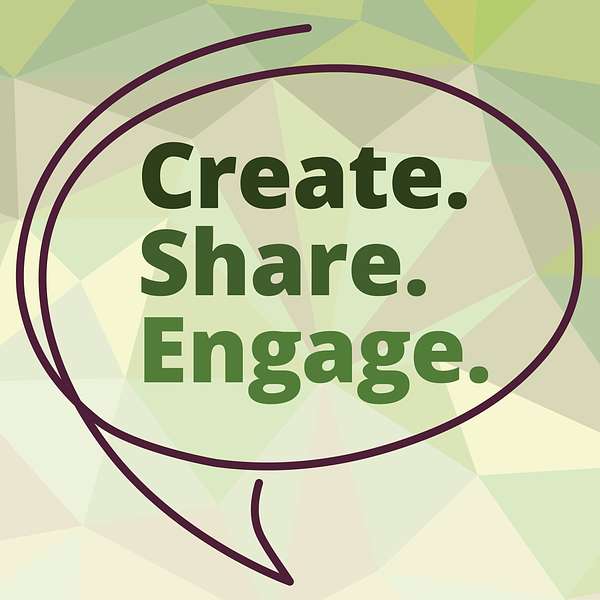
Create. Share. Engage.
Portfolios for learning and more brought to you by the Mahara team at Catalyst IT. Host Kristina Hoeppner talks with portfolio practitioners, researchers, learning designers, students, and others about their portfolio story.
Create. Share. Engage.
The wunderkammer: Metaphors in portfolio practice
Kristina Hoeppner (Catalyst IT), host of this podcast, delves into metaphors used to explain how to work with portfolios in this solo episode. This is the first short episode in a new series that will be published throughout the year in which she explores concepts and ideas around portfolio practice.
Connect with Kristina
- Fediverse (Mastodon)
- Mahara page on LinkedIn
Resources
- Episode 35 with Ruth Cox and Kevin Kelly
- Shada, A.; Kelly, K.; Cox, R. & Malik, S. (2011). Growing a New Culture of Assessment: Planting ePortfolios in the Metro Academies Program. International Journal of ePortfolio, 1(1), 71-83.
- The gallery or museum metaphor, shared by Mandia Mentis and Wendy Holley-Boen
- Coleman, K.S. (2017). An a/r/tist in wonderland: Exploring identity, creativity and digital portfolios as a/r/tographer, Ph.D. dissertation, Melbourne Graduate School of Education, University of Melbourne, Australia, 2017.
- The performance or performance hall metaphor, shared by Hazel Owen
Subscribe to the monthly newsletter about Mahara and portfolios.
Production information
Production: Catalyst IT
Host: Kristina Hoeppner
Artwork: Evonne Cheung
Music: The Mahara tune by Josh Woodward
00:05
Welcome to 'Create. Share. Engage.' This is the podcast about portfolios for learning and more for educators, learning designers, and managers keen on integrating portfolios with their education and professional development practices. 'Create. Share. Engage.' is brought to you by the Mahara team at Catalyst IT. My name is Kristina Hoeppner.
00:30
Today's a solo episode. I want to explore this format together with you and plan to publish a few short episodes throughout the year. My aim with that series really is to take a look at a concept or feature of a portfolio and give you a brief overview of it so you can then investigate it further. This series is also an invitation to you to share your story on the topic in a future episode, so we can hear first hand how you are using a particular concept or feature in your own teaching and learning.
01:10
The first concept that introduces this new series is the metaphor. If you've seen one or more presentations of mine, you know that I love visuals and finding the right picture to illustrate a point. I like to find ways to connect the unfamiliar with the familiar to get the "Oh that's what you mean!" response. A metaphor often makes it easier to grasp a new concept or idea because you're comparing it to something your learners already know. We encounter metaphors all the time, and I bet you've also made use of them quite a lot. So let's wrap our head around how metaphors can be used when working with portfolios.
02:00
Metaphors, I think, are used in two different ways in portfolio practice. They're used to explain how to work with portfolios, and they are used in portfolios to tell the story of the portfolio creator. Today, I'm focusing on the metaphors used to explain how to work with portfolios.
02:25
In the last episode, Dr Ruth Cox and Dr Kevin Kelly shared their metaphor of ePorticulture. That is a combination of 'ePortfolio' and 'culture' and sounds a bit like 'horticulture'. Both being avid gardeners employing a horticulture metaphor made perfect sense to them and their team. They started out with preparing the soil, then plant the seeds or transplant the plants, then the garden grows and they maintain it, and in the end, they harvest a crop. For the portfolio that translates into getting faculty buy-in and support from the institution as well as encouraging students to start articulating their goals and professional identity in the 'preparing the soil' part of the cycle. They then continue with adopting the ePortfolio technology and developing processes to work with portfolios, including the creation of assignments that are opportunities for students to reflect on their learning in relation to their goals. This is the 'planting seeds or transplanting plants' part. Next up is the 'growing and maintaining' part of the cycle, which translates to providing ongoing support for both faculty and students in how to work with portfolios and why they are useful. The last part of the cycle is 'harvesting', which is the creation of the final portfolio and the sharing of it with a selected audience.
04:09
Using a familiar concept, the garden, it's now easy for faculty and students to understand the individual areas of how they get from their learning to their portfolio, even if they are not gardeners themselves. There are only four steps involved: preparation, planting, growth and maintenance, and the harvest.
04:36
Let's take a look at another metaphor that is often used in Portfolio practice. That's the one of an art gallery or museum. This metaphor is described in more detail in the Mahara manual and references how Dr Mandia Mentis and Dr Wendy Holley-Boen from Massey University in Aotearoa New Zealand use it with their education students. They also have four components to their metaphor: the basement, a room in the gallery, the entire exhibition, and the entrance to the exhibition. Translating that to portfolios, they state that the basement is essentially where you store all your learning evidence, all your artefacts and where you also organise them, so you can find them more easily later on. When it comes to creating a portfolio, which is a room in the gallery, you decide what you would like to pull from the basement and thus curate your content. You would hardly ever show everything that you have in the basement in a gallery. Instead, you curate your learning evidence based on the topic of the portfolio, and thus its purpose.
05:58
Now, often a gallery doesn't just consist of one room, but an exhibit can be spread across multiple rooms. You can do the same with portfolios. It doesn't have to show all your evidence on a single page, but you can assist the audience who navigate through your portfolio by creating multiple pages in which you organise your content logically and also give your audience the time to pause but also the immediate link between the individual pages and how they relate to each other.
06:34
Lastly, while some galleries or museums are free to the public, some may require an entrance fee or some exhibitions may incur a fee whereas the rest of the museum is free. The fee in the case of the portfolio can be the access which portfolio authors can limit to specific students, their educator, their institution, or they can also make it fully public. The familiar concept of how a gallery or a museum works is used to explain portfolio work.
07:11
A third metaphor that I'd like to highlight is the wunderkammer. And no, I'm not doing that because I'd like to introduce a fun German word to you, but a metaphor that I learned about in Dr Kathryn's Coleman's PhD thesis 'An a/r/tist in Wonderland: Exploring identity, creativity, and digital portfolios as a/r/tographer'. A wunderkammer is essentially a cabinet of curiosities where items are collected and curated. They are displayed to tell a story and make connections amongst each other based on what the collector encountered on their travels, and what they found interesting to make a note of and interesting to collect.
08:02
Now, there are many, many more metaphors besides the garden, the gallery, and the wunderkammer that are used to explain what portfolios are and how you can work with them. For example, you can liken it to a performance or a performance hall. This metaphor is explained in more detail in the Mahara manual as well, and I link to it in the show notes. There's also the wardrobe metaphor, where you organise your wardrobe each season and curate its content based on the season so that you add new things, you remove things from the old season that you might keep, put it into a suitcase in the attic or in the basement, or maybe there are even some items that you remove entirely. Sigi Jakob-Kühn, a pioneer of using Mahara in Germany used the fridge to explain curation and organisation to her vocational students, and others use a scrapbook or a digital filing cabinet to bring the idea of portfolios closer to their learners.
09:12
No matter the metaphor that you use, they all have something in common. And that is the curation and organisation of the evidence along with a reflection on it. So is this evidence worthwhile showing in my current context? And if that's the case, why is that so?
09:37
So how do you select a metaphor? I think a metaphor must work for both you and your learners. If you live on a flat island, a fishing metaphor is probably going to be more successful with your school students than one about mountaineering in winter as your learners can relate to fishing more easily than to climbing mountains, which probably none of them have ever done not living anywhere near a mountain, let alone a mountain with snow. If you teach fashion design, choosing the wardrobe metaphor or one that relates portfolio work to sewing projects can be successful as your learners will be familiar with these concepts and therefore understand the metaphor easily.
10:29
A metaphor is also not set in stone, I find. It can even be a fun activity to do with your learners when you introduce the metaphor to ask them what they find is also important in this metaphor and then explore how that can be related to portfolio work. So try different ways to introduce your metaphor and watch for your learners' reactions and see what works for them and what you might like to keep in your metaphor and what you might like to change.
11:05
Because in the end, it comes down to how you connect to your learners and let them see that they are already familiar with certain parts of portfolio practice as they have been doing it already. They are now transferring their knowledge from one area to a new one, but don't have to start from scratch. By using a familiar concept in a new space, they can make a comparison and get going more easily.
11:35
Now, I'm curious as to what metaphor or metaphors you are using to introduce portfolios to your learners. Do you have a favourite one that works well for you? Do you use a discipline specific metaphor or one that stems from general life experience? If you do have one, please do get in touch.
12:00
This was 'Create. Share. Engage.' Head to our website podcast.mahara.org where you can find resources and the transcript for this episode. This podcast is produced by Catalyst IT, and I'm your host, Kristina Hoeppner, project lead and product manager of the portfolio platform Mahara. Our next episode will air in two weeks. I hope you'll listen again and tell a colleague about it so they can subscribe. Until then, create, share, and engage.
Podcasts we love
Check out these other fine podcasts recommended by us, not an algorithm.

Agile Ed
Dr. Lindsay Richardson & Dr. Ashley Thompson
The Moodle Podcast
Moodle Podcast
Teaching in Higher Ed
Bonni Stachowiak
Think UDL
Think UDL
Accessagogy
Ann Gagne
